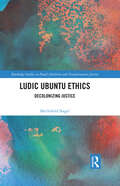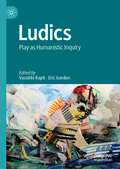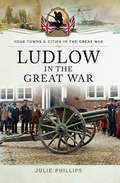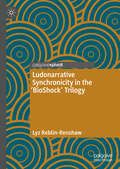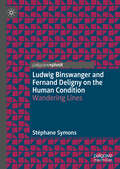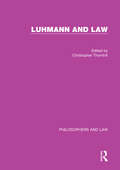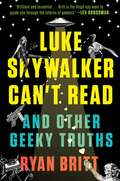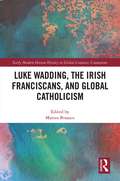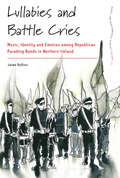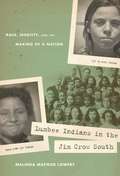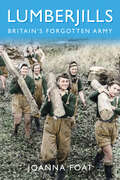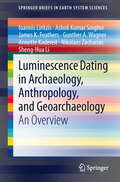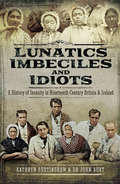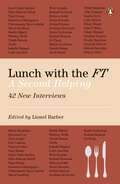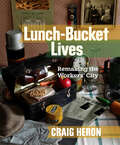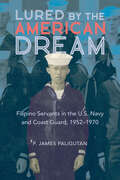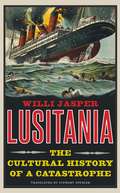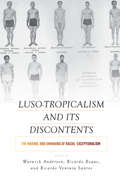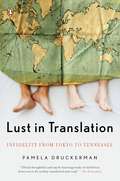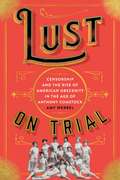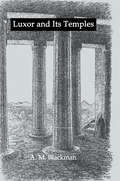- Table View
- List View
Ludic Ubuntu Ethics: Decolonizing Justice (Routledge Studies in Penal Abolition and Transformative Justice)
by Mechthild NagelLudic Ubuntu Ethics develops a positive peace vision, taking a bold look at African and Indigenous justice practices and proposes new relational justice models. ‘Ubuntu’ signifies shared humanity, presenting us a sociocentric perspective of life that is immensely helpful in rethinking the relation of offender and victim. In this book, Nagel introduces a new theoretical liberation model—ludic Ubuntu ethics—to showcase five different justice conceptions through a psychosocial lens, allowing for a contrasting analysis of negative Ubuntu (eg., through shaming and separation) towards positive Ubuntu (eg., mediation, healing circles, and practices that no longer rely on punishment). Providing a novel perspective on penal abolitionism, the volume draws on precolonial (pre-carceral) Indigenous justice perspectives and Black feminism, using discourse analysis and a constructivist approach to justice theory. Nagel also introduces readers to a post secular turn by taking seriously the spiritual dimensions of healing from harm and highlighting the community’s response. Spanning disciplinary boundaries and aimed at readers seeking to understand how to move beyond reintegrative shaming and restorative justice theories, the volume will engage scholars of criminology, philosophy and law, and more specifically penal abolitionism, social ethics, peace studies, African studies, critical legal studies, and human rights. It will also be of great interest to practitioners and activists in restorative justice, mediation, social work, and performance studies.
Ludics: Play as Humanistic Inquiry (Studies In Surrealism Ser.)
by Eric Gordon Vassiliki RaptiThis book establishes play as a mode of humanistic inquiry with a profound effect on art, culture and society. Play is treated as a dynamic and relational modality where relationships of all kinds are forged and inquisitive interdisciplinary engagement is embraced. Play cultivates reflection, connection, and creativity, offering new epistemological directions for the humanities. With examples from a range of disciplines including poetry, history, science, religion and media, this book treats play as an object of inquiry, but also as a mode of inquiry. The chapters, each focusing on a specific cultural phenomenon, do not simply put culture on display, they put culture in play, providing a playful lens through which to see the world. The reader is encouraged to read the chapters in this book out of order, allowing constructive collision between ideas, moments in history, and theoretical perspectives. The act of reading this book, like the project of the humanities itself, should be emergent, generative, and playful.
Ludlow in the Great War (Your Towns & Cities in the Great War)
by Julie PhillipsWars affect everyone. Whether they are fought on the battlefields or on the home front, by the armed forces or civilians, sacrifices have to be made, and everyone suffers one way or another. This book gives a flavour of what it was like to live in Ludlow through the Great War years. Ludlow was proud to send its brothers, husbands, uncles and fathers to fight for King and Country, many of whom had never been far from home before, some who came from decorated service backgrounds for whom the armed services was in their blood. Rich or poor, farm worker, office manager or son of a wealthy estate owner, they all united to defend their town and protect British values and way of life. Life continued as usual for many of those on the home front despite, amongst other things, the introduction of DORA, rationing and the loss of the labour force from the farms. Ludlow was already generous in its giving to the poor but this was taken to a whole new level with the introduction of many national and local war charities. They knitted, sewed, auctioned and sung their way through the war even a patriotic donkey called Willie and a pig did their bit by being auctioned several times to raise money for the war effort.This show of patriotism and stoicism was made against the backdrop of a bloody and heinous war that went on far longer than anticipated. The constant threat of receiving the dreaded telegram indicating their loved ones fate was never far from the minds of Ludlow's civilians, yet the people of Ludlow kept the home fires burning brightly.
Ludonarrative Synchronicity in the 'BioShock' Trilogy
by Lyz Reblin-RenshawThis book presents a new methodology, ludonarrative synchronicity, to analyze the interplay between narrative and gameplay in video games. Using the BioShock franchise as a case study, this book aims to show the interaction of these two elements can form various subjects. Rather than prioritizing one over the other, ludonarrative synchronicity seeks to explore how video game texts function. By analyzing a trio of games focused on choice and control, this book manages to show how players, along with developers, can create their own subjects. Ludonarrative Synchronicity in the BioShock Trilogy will appeal not only to fans of the franchise, but to students and scholars of narrative theory, game design, and posthumanism.
Ludwig Binswanger and Fernand Deligny on the Human Condition: Wandering Lines
by Stéphane SymonsPhilosophical thinking allows itself to be nourished by seemingly non-committal exercises of thought but at the same time seeks forms of irrefutable knowledge. Because of this focus on both the subjective and the universal, philosophy also falls for the lure of the “what-if?” question. What if two legendary artists, writers or philosophers, who did not know each other, did enter into a conversation? In this book, Stéphane Symons outlines an (im)possible conversation between Swiss psychiatrist and philosopher Ludwig Binswanger (1881-1966) and French educator, philosopher, poet and filmmaker Fernand Deligny (1913-1996). Although the two never met, this imaginary conversation can offer insight into both authors' thinking and the human condition. According to Binswanger, self-awareness and social consciousness are the most important and characteristic features of human beings. In contrast, from his contacts with children and adolescents with autism, Deligny emphasizes our ability to interact with the material environment, especially with seemingly insignificant things and nature. Bringing the two thinkers into conversation, Symons sheds new light on what it is to be truly human. In the process, leading roles are played by one of Binswanger's patients, Ellen West, and a young boy with autism, Janmari.
Luhmann and Law (Philosophers And Law Ser.)
by Christopher ThornhillNiklas Luhmann wrote a number of works which have decisively shaped the recent development of legal science as a theoretical discipline. Some basic elements of his theory have been widely appropriated by other legal theorists, such that it is difficult to imagine contemporary reflection in legal theory, and above all legal sociology, without Luhmann. This collection brings together the most important canonical and cutting-edge papers on Luhmann’s legal thought. It is introduced in a comprehensive editorial piece by the editor which locates the articles in context and explores the issues and topics at hand.
Luke Skywalker Can't Read: And Other Geeky Truths
by Ryan Britt"Ryan Britt is . . . the Virgil you want to guide you through the inferno of geekery." --Lev Grossman, author of the bestselling Magician's trilogy Pop Culture and sci-fi guru Ryan Britt has never met a monster, alien, wizard, or superhero that didn't need further analysis. Essayist Ryan Britt got a sex education from dirty pictures of dinosaurs, made out with Jar-Jar Binks at midnight, and figured out how to kick depression with a Doctor Who Netflix-binge. Alternating between personal anecdote, hilarious insight, and smart analysis, Luke Skywalker Can't Read contends that Barbarella is good for you, that monster movies are just romantic comedies with commitment issues, that Dracula and Sherlock Holmes are total hipsters, and, most shockingly, shows how virtually everyone in the Star Wars universe is functionally illiterate. Romp through time and space, from the circus sideshows of 100 years ago to the Comic Cons of today, from darkest corners of the Galaxy to the comfort of your couch. For anyone who pretended their flashlight was a lightsaber, stood in line for a movie at midnight, or dreamed they were abducted by aliens, Luke Skywalker Can't Read is full of answers to questions you haven't thought to ask, and perfect for readers of Chuck Klosterman, Rob Sheffield, and Ernest Cline.From the Trade Paperback edition.
Luke Wadding, the Irish Franciscans, and Global Catholicism (Early Modern Iberian History in Global Contexts)
by Matteo BinascoThis book explores the endeavors and activities of one of the most prominent early modern Irishmen in exile, the Franciscan Luke Wadding. Born in Ireland, educated in the Iberian Peninsula, Wadding arrived in Rome in 1618, where he would die in 1657. In the "Eternal City," the Franciscan emerged as an outstanding theologian, a learned scholar, a diplomat, and a college founder. This innovative collection of chapters brings together a group of international scholars who provide a ground-breaking analysis of the many cultural, political, and religious facets of Wadding&’s life. They illustrate the challenges and changes faced by an Irishman who emerged as one of the most outstanding global figures of the Catholic Reformation. The volume will attract scholars of the early modern period, early modern Catholicism, and Irish emigration.
Lullabies and Battle Cries: Music, Identity and Emotion among Republican Parading Bands in Northern Ireland (Dance and Performance Studies #13)
by Jaime RollinsSet against a volatile political landscape, Irish republican culture has struggled to maintain continuity with the past, affirm legitimacy in the present, and generate a sense of community for the future. Lullabies and Battle Cries explores the relationship between music, emotion, memory, and identity in republican parading bands, with a focus on how this music continues to be utilized in a post-conflict climate. As author Jaime Rollins shows, rebel parade music provides a foundational idiom of national and republican expression, acting as a critical medium for shaping new political identities within continually shifting dynamics of republican culture.
Lumbee Indians in the Jim Crow South
by Malinda Maynor LoweryWith more than 50,000 enrolled members, North Carolina's Lumbee Indians are the largest Native American tribe east of the Mississippi River. Malinda Maynor Lowery, a Lumbee herself, describes how, between Reconstruction and the 1950s, the Lumbee crafted and maintained a distinct identity in an era defined by racial segregation in the South and paternalistic policies for Indians throughout the nation. They did so against the backdrop of some of the central issues in American history, including race, class, politics, and citizenship.Lowery argues that "Indian" is a dynamic identity that, for outsiders, sometimes hinged on the presence of "Indian blood" (for federal New Deal policy makers) and sometimes on the absence of "black blood" (for southern white segregationists). Lumbee people themselves have constructed their identity in layers that tie together kin and place, race and class, tribe and nation; however, Indians have not always agreed on how to weave this fabric into a whole. Using photographs, letters, genealogy, federal and state records, and first-person family history, Lowery narrates this compelling conversation between insiders and outsiders, demonstrating how the Lumbee People challenged the boundaries of Indian, southern, and American identities.
Lumberjills: Britain's Forgotten Army
by Joanna FoatWhen war was declared in 1939, Britain was almost completely dependent on imported timber – but only had seven months of it stockpiled. Timber was critical to the war effort: it was needed for everything from aircraft and shipbuilding to communications and coal mining. The British timber trade was in trouble. Enter the Lumberjills. Lacking in both men and timber, the government made a choice. Reluctantly, they opened lumber work for women to apply – and apply they did. The Women’s Timber Corps had thousands of members who would prove themselves as strong and as smart as any man: they felled and crosscut trees by hand, operated sawmills, and ran whole forestry sites. They may not have been on the front line, but they fought their own battles on the home front for respect and equality. And in the midst of heavy labour and wartime, they lived a life, making firm friends and even finding soulmates. In Lumberjills, researcher Joanna Foat tells their story for the first time, and gives them the recognition they so truly deserve.
Luminescence Dating in Archaeology, Anthropology, and Geoarchaeology: An Overview
by Annette Kadereit Ioannis Liritzis Sheng-Hua Li Rudolf Wagner Jim Feathers Nikolaos Zacharias Ashok SinghviThe field of Luminescence Dating has reached a level of maturity. Both research and applications from all fields of archaeological science, from archaeological materials to anthropology and geoarchaeology, now routinely employ luminescence dating. The advent of optically stimulated luminescence (OSL) techniques and the potential for exploring a spectrum of grain aliquots enhanced the applicability, accuracy and the precision of luminescence dating. The present contribution reviews the physical basis, mechanisms and methodological aspects of luminescence dating; discusses advances in instrumentations and facilities, improvements in analytical procedures, and statistical treatment of data along with some examples of applications across continents, covering all periods (Middle Palaeolithic to Medieval) and both Old and New World archaeology. They also include interdisciplinary applications that contribute to palaeo-landscape reconstruction.
Lunatic Asylums in Colonial Bombay: Shackled Bodies, Unchained Minds (Mental Health in Historical Perspective)
by Sarah Ann PintoThis book traces the historical roots of the problems in India’s mental health care system. It accounts for indigenous experiences of the lunatic asylum in the Bombay Presidency (1793-1921). The book argues that the colonial lunatic asylum failed to assimilate into Indian society and therefore remained a failed colonial-medical enterprise. It begins by assessing the implications of lunatic asylums on indigenous knowledge and healing traditions. It then examines the lunatic asylum as a ‘middle-ground’, and the European superintendents’ ‘common-sense’ treatment of Indian insanity. Furthermore, it analyses the soundscapes of Bombay’s asylums, and the extent to which public perceptions influenced their use. Lunatic asylums left a legacy of historical trauma for the indigenous community because of their coercive and custodial character. This book aims to disrupt that legacy of trauma and to enable new narratives in mental health treatment in India.
Lunatics, Imbeciles and Idiots: A History of Insanity in Nineteenth-Century Britain and Ireland
by Kathryn Burtinshaw Dr. John Burt&“Reveals the grisly conditions in which the mentally ill were kept . . . [and] harrowing details of the inhumane and gruesome treatment of these patients.&”—Daily Mail In the first half of the nineteenth century, treatment of the mentally ill in Britain and Ireland underwent radical change. No longer manacled, chained and treated like wild animals, patient care was defined in law and medical understanding, and treatment of insanity developed. Focusing on selected cases, this new study enables the reader to understand how progressively advancing attitudes and expectations affected decisions, leading to better legislation and medical practice throughout the century. Specific mental health conditions are discussed in detail and the treatments patients received are analyzed in an expert way. A clear view of why institutional asylums were established, their ethos for the treatment of patients, and how they were run as palaces rather than prisons giving moral therapy to those affected becomes apparent. The changing ways in which patients were treated, and altered societal views to the incarceration of the mentally ill, are explored. The book is thoroughly illustrated and contains images of patients and asylum staff never previously published, as well as first-hand accounts of life in a nineteenth-century asylum from a patient&’s perspective. Written for genealogists as well as historians, this book contains clear information concerning access to asylum records and other relevant primary sources and how to interpret their contents in a meaningful way. &“Through the use of case studies, this book adds a personal note to the historiography in a way that is often missing from scholarly works.&”—Federation of Family History Societies
Lunch with the FT: A Second Helping
by Lionel BarberLunch with the FT has been a permanent fixture in the Financial Times for almost 30 years, featuring presidents, film stars, musical icons and business leaders from around the world.The column is now a well-established institution, which has reinvigorated the art of conversation in the convivial, intimate environment of a long and boozy lunch.This new and updated edition includes lunches with:Elon MuskDonald TrumpHilary MantelRichard BransonZadie SmithNigel FarageRussell BrandDavid GuettaYanis VaroufakisJean-Claude JunckerGwyneth PaltrowRebecca SolnitJordan PetersonChimamanda Ngozi AdichieAnd more...
Lunch-Bucket Lives: Remaking the Workers’ City
by Craig HeronLunch-Bucket Lives takes the reader on a bumpy ride through the history of Hamilton’s working people from the 1890s to the 1930s. It ambles along city streets, peers through kitchen doors and factory windows, marches up the steps of churches and fraternal halls, slips into saloons and dance halls, pauses to hear political speeches, and, above all, listens for the stories of men, women, youths, and children from families where people relied mainly on wages to survive. Heron takes wage-earning as a central element in working-class life, but also looks beyond the workplace into the households and neighbourhoods—settlement patterns and housing, marriage, child care, domestic labour, public health, schooling, charity and social work, popular culture, gender identities, ethnicity and ethnic conflict, and politics in various forms—presenting a comprehensive view of working-class life in the first half of the twentieth century. This book has been published with the help of a grant from the Federation for the Humanities and Social Sciences, through the Awards to Scholarly Publications Program, using funds provided by the Social Sciences and Humanities Research Council of Canada.
Lunáticos viajantes: Las increíbles andanzas de Los Redondos en Uruguay
by Jorge CostiglioloA 20 años de su último recital en Montevideo conoceremos la historia, anécdotas y protagonistas de una relación de amor, pasión y rock and roll. Desde su nacimiento a fines de los años 70 en la de La Plata Patricio Rey y sus redonditos de ricota se convirtieron en un fenómeno cultural casi exclusivo de Argentina, salvo por Uruguay. Este libro repasa a través de testimonios, historias, anécdotas, mitos, verdades y leyendas las veces de cómo, cuándo y de qué manera Los Redondos se vincularon con Uruguay.
Lured by the American Dream: Filipino Servants in the U.S. Navy and Coast Guard, 1952-1970 (Asian American Experience)
by P. James PaligutanStarting in 1952, the United States Navy and Coast Guard actively recruited Filipino men to serve as stewards--domestic servants for officers. Oral histories and detailed archival research inform P. James Paligutan's story of the critical role played by Filipino sailors in putting an end to race-based military policies. Constrained by systemic exploitation, Filipino stewards responded with direct complaints to flag officers and chaplains, rating transfer requests that flooded the bureaucracy, and refusals to work. Their actions had a decisive impact on seagoing military’s elimination of the antiquated steward position. Paligutan looks at these Filipino sailors as agents of change while examining the military system through the lens of white supremacy, racist perceptions of Asian males, and the motives of Filipinos who joined the armed forces of the power that had colonized their nation. Insightful and dramatic, Lured by the American Dream is the untold story of how Filipino servicepersons overcame tradition and hierarchy in their quest for dignity.
Lusitania: The Cultural History of a Catastrophe
by Willi Jasper Mr Stewart SpencerA fascinating reassessment of a turning point in the First World War, revealing its role in shaping the German psyche On May 7, 1915, the Lusitania, a large British luxury liner, was sunk by a German submarine off the Irish coast. Nearly 1,200 people, including 128 American citizens, lost their lives. The sinking of a civilian passenger vessel without warning was a scandal of international scale and helped precipitate the United States' decision to enter the conflict. It also led to the immediate vilification of Germany. Though the ship's sinking has preoccupied historians and the general public for over a century, until now the German side of the story has been largely untold. Drawing on varied German sources, historian Willi Jasper provides a comprehensive reappraisal of the sinking and its aftermath that focuses on the German reaction and psyche. The attack on the Lusitania, he argues, was not simply an escalation of violence but signaled a new ideological, moral, and religious dimension in the struggle between German Kultur and Western civilization.
Luso-Tropicalism and Its Discontents: The Making and Unmaking of Racial Exceptionalism
by Warwick Anderson Ricardo Ventura Santos Ricardo RoqueModern perceptions of race across much of the Global South are indebted to the Brazilian social scientist Gilberto Freyre, who in works such as The Masters and the Slaves claimed that Portuguese colonialism produced exceptionally benign and tolerant race relations. This volume radically reinterprets Freyre’s Luso-tropicalist arguments and critically engages with the historical complexity of racial concepts and practices in the Portuguese-speaking world. Encompassing Brazil as well as Portuguese-speaking societies in Africa, Asia, and even Portugal itself, it places an interdisciplinary group of scholars in conversation to challenge the conventional understanding of twentieth-century racialization, proffering new insights into such controversial topics as human plasticity, racial amalgamation, and the tropes and proxies of whiteness.
Lust in Translation: Infidelity from Tokyo to Tennessee
by Pamela DruckermanCompared to the citizens of just about every other nation, Americans are the least adept at having affairs, have the most trouble enjoying them, and suffer the most in their aftermath and Pamela Druckerman has the facts to prove it. The journalist's surprising findings include: Russian spouses don't count beach resort flings as infidelity South Africans consider drunkenness an adequate excuse for extramarital sex Japanese businessmen believe, "If you pay, it's not cheating."Voyeuristic and packed with eyebrow-raising statistics and interviews, Lust in Translation is her funny and fact-filled world tour of infidelity that will give new meaning to the phrase "practicing monogamy."
Lust on Trial: Censorship and the Rise of American Obscenity in the Age of Anthony Comstock
by Amy WerbelAnthony Comstock was America’s first professional censor. From 1873 to 1915, as Secretary of the New York Society for the Suppression of Vice, Comstock led a crusade against lasciviousness, salaciousness, and obscenity that resulted in the confiscation and incineration of more than three million pictures, postcards, and books he judged to be obscene. But as Amy Werbel shows in this rich cultural and social history, Comstock’s campaign to rid America of vice in fact led to greater acceptance of the materials he deemed objectionable, offering a revealing tale about the unintended consequences of censorship.In Lust on Trial, Werbel presents a colorful journey through Comstock’s career that doubles as a new history of post–Civil War America’s risqué visual and sexual culture. Born into a puritanical New England community, Anthony Comstock moved to New York in 1868 armed with his Christian faith and a burning desire to rid the city of vice. Werbel describes how Comstock’s raids shaped New York City and American culture through his obsession with the prevention of lust by means of censorship, and how his restrictions provided an impetus for the increased circulation and explicitness of “obscene” materials. By opposing women who preached sexual liberation and empowerment, suppressing contraceptives, and restricting artistic expression, Comstock drew the ire of civil liberties advocates, inspiring more open attitudes toward sexual and creative freedom and more sophisticated legal defenses. Drawing on material culture high and low, including numerous examples of the “obscenities” Comstock seized, Lust on Trial provides fresh insights into Comstock’s actions and motivations, the sexual habits of Americans during his era, and the complicated relationship between law and cultural change.
Lust und Abgrund: Theologische und kulturwissenschaftliche Zugänge zum Begehren (pop.religion: lebensstil – kultur – theologie)
by Richard Janus Harald Schroeter-WittkeDas Buch beleuchtet die Komplexe Lust, Begehren und Abgrund in popkulturellen Darstellungen aus theologischer und kulturwissenschaftlicher Perspektive.
Luttes paysannes en Colombie 1970-2016: Conflit agraire et perspectives de paix (Études en développement international et mondialisation)
by Leila CelisLa lutte pour la terre : voilà l’une des questions centrales du conflit en Colombie. Cette étude porte sur la logique et les actions des acteurs sociaux et armés dans cette lutte, et explore les conditions essentielles à la construction de la paix. Ce livre retrace l’évolution du mouvement agraire depuis les années 1970 en dégageant quatre phases ou dynamiques distinctes : autogestion, réclamation, résistance et autodétermination. Dans la première, les paysans luttent principalement pour la terre à travers la colonisation des terres publiques et l’occupation des terres de grands propriétaires. Dans la deuxième, ils se mobilisent pour revendiquer des investissements publics dans la vie et la production agricole. La troisième phase de la lutte paysanne correspond à la résistance juridique et aux déplacements intraterritoriaux devant la violence paramilitaire. Finalement, la quatrième phase correspond à la lutte actuelle contre l’extractivisme et pour l’autonomie territoriale. L’étude se base principalement sur l’histoire de l’Association nationale des paysans de la Colombie (ANUC), fondée en 1967, de la Fédération des paysans et des mineurs artisanaux du sud de Bolivar (FEDEAGROMISBOL), fondée en 1985, et de la Coordination nationale agraire (CNA), fondée en 1997. Ces organisations regroupent des paysans, petits et moyens propriétaires, dont la propriété n’est pas complètement légalisée et qui exploitent la terre dans des conditions précaires. Publié en français
Luxor And Its Temples
by A.M. BlackmanFirst published in 2005. Routledge is an imprint of Taylor & Francis, an informa company.
